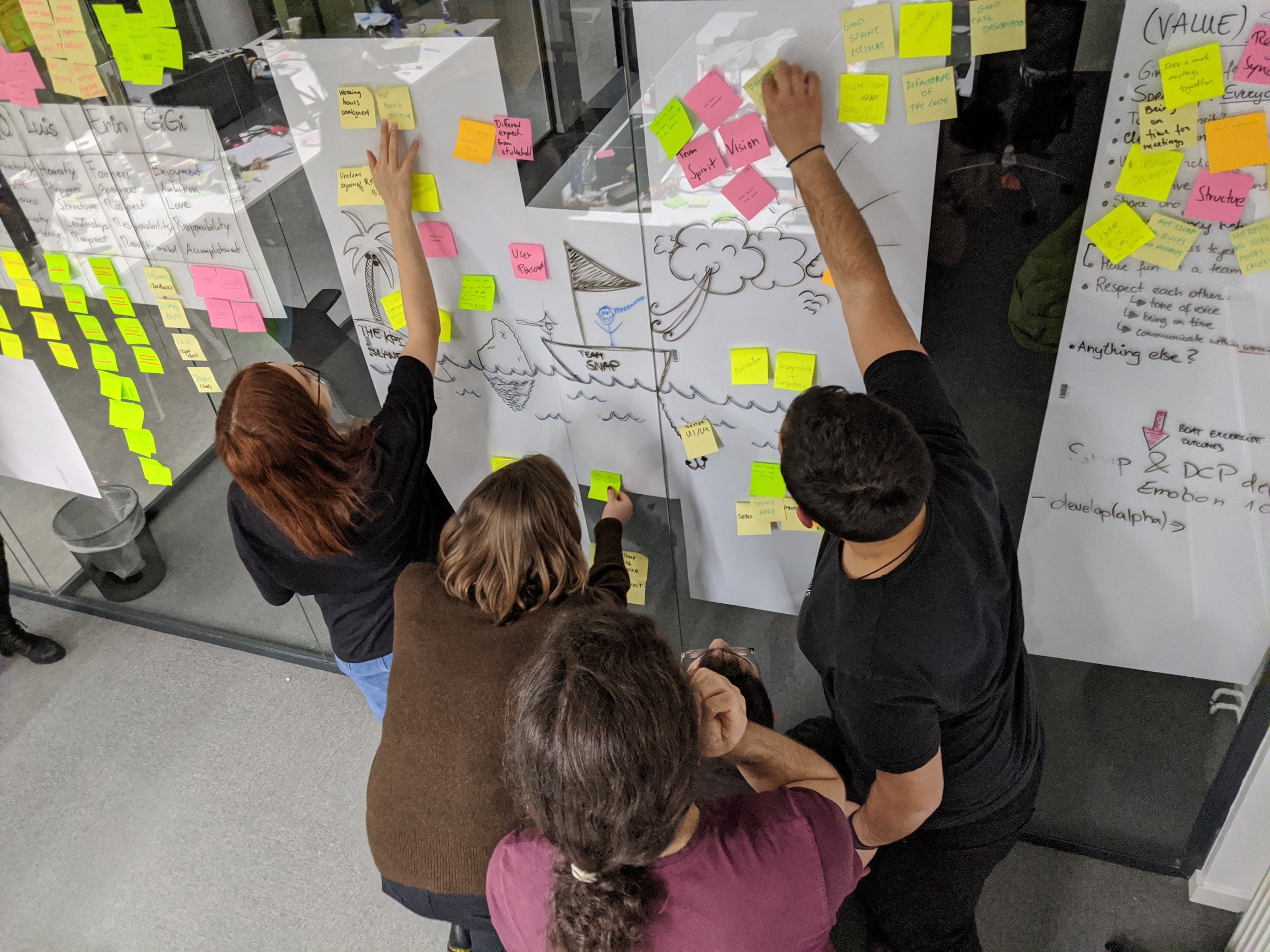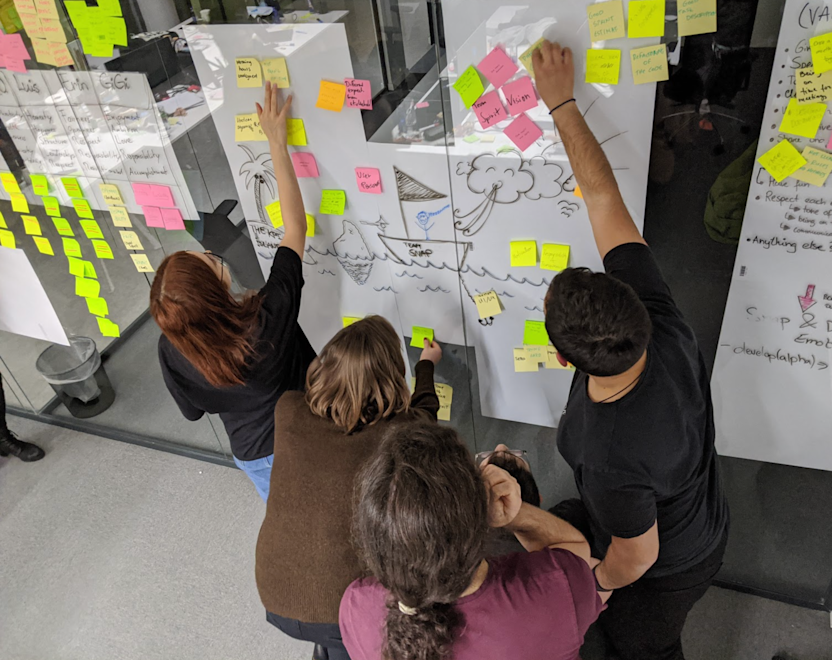
Techniques to Unite a Distributed Team - Part II
In Part I of Techniques to Unite a Distributed Team, I described the first day of Celonis Free on-site team workshop, revealing the methods we applied to define our Goals and Values as a distributed product team. This article presents the second (final) day of the workshop - the Action Plan. The Action Plan is focused around utilizing the insights from the Goals and Values workshops, and transforming them into something more tangible - the Team’s Manifesto and the Action list.
To see how the principles defined during the Action Plan workshop are now guiding us through successful and productive collaboration as a fully remote team, check out my Working Remotely - Principles for Successful Team Collaboration article.
—
Day 1 of the workshop had generated lots of valuable insights: We discussed our individual and team goals to align on our expectations, and shared our thoughts on the values and the environment that would enable us to move forward. What’s more important, however, was that these exercises had fostered a friendly and welcoming team atmosphere. This was a perfect time to bring some clarity to the table and define our Action Plan.
Same as during the Goals and Values workshops, you will need: Post-it notes, Whiteboard, Markers, Cardboard. Silent brainstorming is still the preferred method for idea generation.
Part 3: The Action Plan.
How will we achieve our goals while staying true to our values?
Sailboat Exercise
To help us to get into the solution mindset, we used the Sailboat Exercise, introduced by Luke Hohmann in his “Innovation Games” book. It is a simple exercise that… puts the team on a boat.
Prior to the workshop, I snuck into the room armed with some colored markers and began to draw an island on the left side of the board and populated it with our previously defined KPIs. Next, I drew a boat in the middle of the board with an anchor attached to it. I finished off the drawing with a sketch of a rock in front of the boat and some wind behind the boat. For inspiration, see this illustration. Once the team arrived, I presented them with the concept of the drawing:
The island represents our team goals (in our case- the KPIs we defined during our Goals workshop)
The boat is our team, trying to reach the KPI island
Anchor attached to the boat symbolizes the things that might be or already are slowing us down (e.g. task overestimation)
Wind is what propels us towards the island (e.g. team spirit)
Finally, the rock represents the potential risks that we can foresee (e.g. varying working hours between the team members)
The team quickly got engaged with the illustration and drew themselves inside the boat as pirates (entirely optional but generates extra fun and relevance points).
When the symbols and the illustration was clarified, we set a timer to 5 min and quietly brainstormed all the possible rocks, winds and anchor points we could think of. After the brainstorming session was over, the team gathered around the drawing and clustered the Post-it notes.
To organize our clusters and ensure that nothing is overlooked, we wrote all the topics under the illustration with sub-descriptions. We then discussed how to overcome our rocks, eliminate anchors and encourage more wind.

TIP:
It is not about the drawing itself but the metaphor. Feel free to use printed objects if drawing is not one of your strengths.
To keep the silence during the brainstorming - but foster idea generation - encourage the team members to place their post-it notes on the respective parts of the drawing during the silent brainstorming and not after.
Mixing up different categories (e.g. rocks and anchors) while clustering the Post-it notes are encouraged. The categories are there to foster more ideas, not to limit the output.
Remember to also discuss how you would acknowledge the positive in team-work and celebrate successes as a team
Team Manifesto (& Action list)
After a rather long coffee break and regaining our energy, we moved on to defining our team's Manifesto.
First, we discussed what the purpose of our manifesto should be. As there is no perfect recipe for a team manifesto, it is important to define it together. Manifesto can be both: a specific and rule-like guide, or a list of inspiring and guiding bullet points. For us, the purpose of the Manifesto was agreed to be the latter; we wanted the manifesto to inspire and guide our behavior.
To generate the content for our manifesto, we sat in a circle and tackled our previously discussed Sailboat exercise findings together with other important notes and concerns gathered from the previous day workshops. As the team members were discussing their take on manifesto points, I noted them down on the board in front of the team for everyone to see. We then revisited each point and spent extensive time shaping them until everyone in the team found it acceptable. If we could not decide whether the bullet point was important enough, we utilised voting.
While defining some of the points for our manifesto, the team often raised specific principles and ground rules despite the agreed manifesto's purpose. This resulted in forming the manifesto in general bullet points while documenting the sub-principles and specific actions in another, separate document (our Action list).
As an outcome, Celonis free team defined a manifesto with 13 clear bullet points, each of which with 1-3 sub-principles.
An example of a manifesto point: We rely on each other for timely communication.
Sub-principle: Our team availability hours are 11am- 5pm. We answer team messages before 11am the next day if the message was sent after 5pm.
TIP:
Write the manifesto by hand and ask your teammates to sign it, it will make the manifesto more personal and official.
If your team comes up with specific action points that need to be taken, jointly delegate team members to drive these actions.
Do not forget to follow up on the manifesto and revisit it once in a while.
Before the workshop, we were a free team- nine bright minds sitting in two offices and pinging each other via Slack messages. Transparent Communication and Work Alignment was a topic that popped up occasionally but got buried under our daily tasks. Now, after having shared our minds and aspirations, and filled-up dozens of Post-it notes, we are the team. Despite the long workshops, we had so much fun that other teams sneaked in to see why we were laughing and clapping for each other. We are united, we have clear goals, and we know what we value. We're is ready to enable process mining for everyone.



